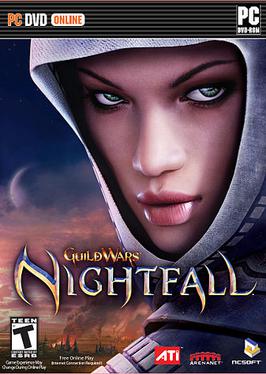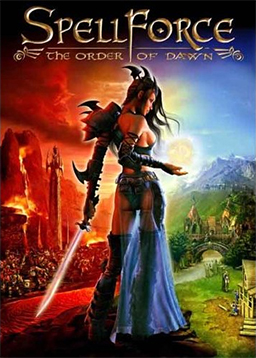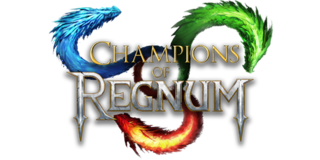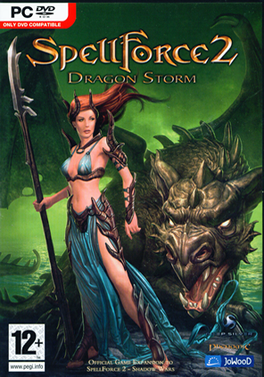Guild Wars is an online role-playing game franchise developed by ArenaNet and published by NCSoft. The games were critically well received and won many editor's choice awards, as well as awards such as "Massively Multiplayer/Persistent World Game of the Year" by the Academy of Interactive Arts & Sciences, as well as Best Value, Best Massively Multiplayer Online Role-Playing Game (MMORPG), and Best Game. Guild Wars was noted for being the "first major MMO to adopt a business model not based on monthly subscription fees", its instanced approach to gameplay, and the quality of the graphics and play for computers with low specifications. In April 2009, NCSoft announced that 6 million units of games in the Guild Wars series had been sold. The sequel and fourth major entry into the series, Guild Wars 2, was announced in March 2007 and released on August 28, 2012. It features updated graphics and gameplay mechanics, and continues the original Guild Wars tradition of no subscription fees. The Guild Wars series had sold 11.5 million copies by August 2015

Dungeons & Dragons: Dragonshard is a real-time strategy role-playing video game, developed for Microsoft Windows by Liquid Entertainment, and published by Atari in September 2005. It takes place in Eberron, one of the official Dungeons & Dragons campaign settings. The game combines elements of traditional real-time strategy gameplay with role-playing elements such as hero units, and questing. Dragonshard includes two single-player campaigns, single-player skirmish maps, and multiplayer support. The single-player campaign follows the struggles of three competing factions to gain control of a magical artifact known as the Heart of Siberys.

Police Quest: SWAT 2 (stylized as SWAT2) is a 1998 real-time tactics video game developed by Yosemite Entertainment and published by Sierra FX (both studios of Sierra On-Line) exclusively for Microsoft Windows. It is the sixth installment in the Police Quest series and the second installment in the SWAT subseries. The game follows the Los Angeles Police Department (LAPD) Metropolitan Division SWAT team as they clash with a domestic terrorist militia launching attacks across Los Angeles.

Fire Emblem: Radiant Dawn is a tactical role-playing game developed by Intelligent Systems and published by Nintendo for the Wii home console. It is the tenth entry in the Fire Emblem series, and acts as a direct sequel to the 2005 GameCube title Fire Emblem: Path of Radiance. It was released in 2007 in Japan and North America, and 2008 in Europe and Australia.

Guild Wars Nightfall is a fantasy action role-playing game and the third stand-alone campaign in the Guild Wars series developed by ArenaNet, a subsidiary of NCSOFT corporation. Nightfall was released worldwide on October 27, 2006, having been in development alongside Guild Wars Factions since November 2005.

SpellForce: The Order of Dawn is a 2003 real-time strategy and role-playing video game, developed by Phenomic Game Development and published by Encore, Inc for Microsoft Windows. First released in Europe on November 11, 2003, the game takes place within a high-fantasy world in the years following a devastating cataclysmic event, with the game's main campaign focusing on the plight of an immortal warrior who seeks to investigate growing troubles amongst some of the islands that have formed.

Guild Wars is a multiplayer online action role-playing game developed by ArenaNet, a subsidiary of South Korean game publisher NCSOFT, and released in 2005. As the original installment of the Guild Wars series, its campaign was retroactively titled Prophecies to differentiate it from the content of subsequent releases. The game contains a co-operative role-playing portion and a competitive Player versus Player (PvP) portion. In PvP, players may use either their co-operative characters or PvP-exclusive characters who are inherently maximum level and have account-based access to unlocked content.

Warhammer 40,000: Dawn of War – Dark Crusade is the second expansion to the real-time strategy video game Warhammer 40,000: Dawn of War developed by Relic Entertainment and published by THQ. Based on Games Workshop's tabletop wargame, Warhammer 40,000, Dark Crusade was released on October 9, 2006. The expansion features two new races, the Tau Empire and the Necrons. Including the Imperial Guard from Dawn of War's first expansion pack Winter Assault, a total of seven playable races in this expansion.

Champions of Regnum is a fantasy massively multiplayer online role-playing game (MMORPG) developed and published by Nimble Giant Entertainment, a game development studio located in Argentina. The game focuses on full Realm vs Realm team player vs player combat, with a three-way war constantly in progress over forts and castles. There are monsters and an element of grinding, but these are considered secondary to the war. It was released on May 24, 2007.

SpellForce 2: Dragon Storm is a 2007 expansion pack developed by Phenomic for the real-time strategy and role-playing game SpellForce 2: Shadow Wars, released in 2006. The expansion features a new story campaign set after the events of the main game, in which players assume the role of an immortal warrior recruited into the Shaikan who finds themselves searching for one of its legendary members, only to discover a new threat that endangers the world of Eo. Along with the new story campaign and an additional skill tree for the main character, players can also build up a base and units based on a new Shaikan faction.

Warhammer 40,000: Dawn of War II is a real-time strategy-tactical role-playing video game developed by Relic Entertainment and published by THQ for Microsoft Windows based on the fictional Warhammer 40,000 universe. It is the sequel to the Warhammer 40,000: Dawn of War video game series. Dawn of War II was released in North America on February 19, 2009 and in Europe on February 20, 2009. A sequel, Warhammer 40,000: Dawn of War III, was released in April 2017.

SpellForce 2: Faith in Destiny is the second expansion for SpellForce 2, developed by Indian studio Trine Games. It was released on June 19, 2012, after several delays.

Grim Dawn is an action role-playing game (ARPG), developed and published by Crate Entertainment for Microsoft Windows in February 2016 and released for Xbox One in December 2021. Developed using the Titan Quest engine, it is set in a thematically dark fictional world loosely based on the Victorian era. It received generally favorable reviews from critics and had sold 7 million units by February 2022.

Warlock: Master of the Arcane is a 4X turn-based strategy video game developed by 1C:Ino-Co Plus and published by Paradox Interactive. It was released for Microsoft Windows on 8 May 2012. A sequel, Warlock II: The Exiled, was released in 2014.
SpellForce is a real-time strategy and role-playing series created by Phenomic and currently owned by THQ Nordic. The first release was published by JoWooD Productions and Encore Software in 2003 and THQ Nordic in 2017.
Warhammer Age of Sigmar is a miniature wargame produced by Games Workshop that simulates battles between armies by using miniature figurines. Games are typically played on a relatively flat surface such as a dining table, bespoke gaming table, or an area of floor. The playing area is often decorated with models and materials representing buildings and terrain. Players take turns taking a range of actions with their models: moving, charging, shooting ranged weapons, fighting, and casting magical spells; the outcomes of which are generally determined by dice rolls. Besides the game itself, a large part of Age of Sigmar is dedicated to the hobby of collecting, assembling and painting the miniature figurines from the game.

Thirty-one full expansions for the MMORPG EverQuest have been released. Initially, expansions were shipped in boxes to stores, but were later put for sale on digital marketplaces. The retail versions often come packaged with a bonus feature such as a creature that the player can put in their in-game house.

SpellForce 3 is a 2017 video game developed by Grimlore Games and published by THQ Nordic. It was released for Microsoft Windows on 7 December 2017. SpellForce 3 is the third full and the ninth overall release in the SpellForce video game series. It is the first entry in the series since 2014's SpellForce 2: Demons of the Past. The plot serves as a prequel to the first game, depicting events that lead to the creation of The Circle, the group of mages whose actions were the basis for The Order of Dawn.

SpellForce 3: Soul Harvest is a 2019 stand-alone expansion pack for SpellForce 3 developed by Grimlore Games and published by THQ Nordic. It was released for Microsoft Windows on 28 May 2019. While it uses the same game engine and assets as SpellForce 3, Soul Harvest does not require the player to have purchased or installed the main game to play it.

Total War: Warhammer III is a turn-based strategy and real-time tactics video game developed by Creative Assembly and published by Sega. It is part of the Total War series, and the third to be set in Games Workshop's Warhammer Fantasy fictional universe. The game was announced on 3 February 2021 and was released on 17 February 2022. It received positive reviews from critics and was nominated for the British Academy Games Award for British Game at the 19th British Academy Games Awards.















